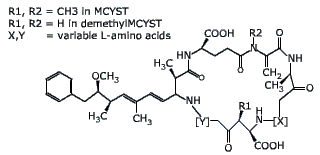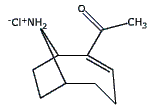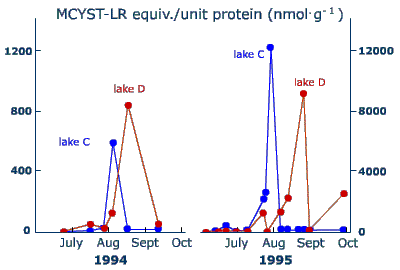 |
|
|
|
|
|
|
1 - Poisoned cattle |
During the last two decades, more than 100 cattle deaths have been recorded in alpine sites in south-eastern Switzerland. The deaths occurred between the middle of August and the middle of September and usually after long periods of relatively warm and dry weather. Pathological findings and histological examination of the organs strongly indicated acute hepatotoxicosis and, in some cases, clinical symptoms suggestive of neurotoxicity. Since cyanobacterial blooms in lakes are known to produce neuro- and hepatotoxic agents, microbial composition of alpine lakes in the surroundings concerned was examined. Two different toxic compounds may be responsible for the cattle deaths. |
Microcystins Microcystins (MCYST) are potent toxins and constitute a large group of cyclic heptapeptides. Upon uptake, death occurs within a few hours, resulting from intrahepatic haemorrhages leading to hypovolemic shock. MCYST inhibits protein phosphatases, a fact that is used to detect small levels of this toxin. |
2 - Microcystin molecule |
Anatoxins The neurotoxic alkaloid Anatoxin-a is a potent postsynaptic cholinergic nicotinic agonist, which, by depolarization, causes partly reversible neuromuscular blockage. |
3 - Anatoxin-a hydrochloride molecule |
|
Toxin producing cyanobacteria |
4 - Anabaena sp. |
5 - Oscillatoria sp. |
Protein phosphatase inhibiting microcystins are produced by species or strains of the cyanobacterial genera Microcystis, Anabaena, Oscillatoria, Nostoc and Hapalosiphon. The cyanobacterial neurotoxin anatoxin-a is produced by Anabaena, Aphanizomenon, Micorcystis, and Oscillatoria. |
|
Cyanobacterial water blooms are known from eutrophic, over fertilized lakes, where they are responsible for mass death of fish. Yet, toxin producing cyanobacterial mats can also be found in oligotrophic alpine lakes. Benthic cyanobacteria develop significant amounts of biomass in some high mountain glacier lakes. Obviously they are well adapted to oligotrophy, to the highly variable environmental conditions (irradiation and temperature extremes, desiccation) and to the short vegetation period. They produce microcystins in annually and seasonally variable concentration. |
6 - Cyanobacterial mats |
|
Annual and seasonal toxin fluctuations |
|
Microcystin concentrations fluctuate strongly with peaks in late summer and enormous differences between years. The microcystin peak concentrations in two adjacent Tambo lakes C and D have a time lag of two weeks. Maximum toxin concentration in 1995 is almost 10 times higher than in 1994 (please notice the ordinate scales). It is not clear which factors lead to toxin production. In one cyanobacterial mat community, biomass and microcystin concentrations were highest at the same time, in another one the microcystin content was maximal three weeks after the highest biomass concentration was reached. |
7 - Microcystin concentration fluctuations (from Mez et al. 1998) |
|
To this day, no direct correlation could be shown between growth and toxin production by these benthic cyanobacteria and one or several environmental factor(s). Mechanical stress, temporary desiccation and strong irradiation, determinants which are direct or indirect consequences of the meteorological conditions, as well as high iron concentration are the most likely factors regulating metabolic processes and thus microcystin production in these mountain habitats. |
29 August 2011 |
||
| |
||






